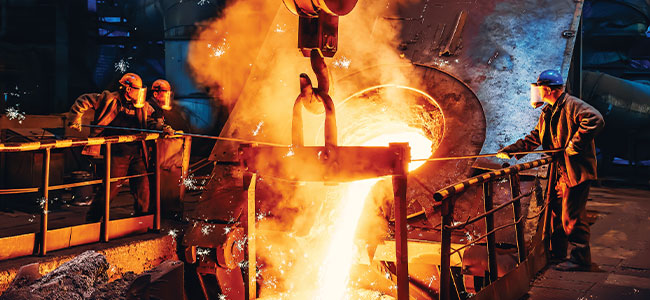
Page 2 of 3
Protecting Workers in High-Heat Industries
Hazards Uncovered
Common hazards identified within the risk assessment for high-heat industries include:
• Thermal burns from splashing hot liquids or contact with hot surfaces
• Chemical burns from exposure to acids, caustics, flammable, and toxic substances
• Back strains and musculoskeletal disorders from awkward positioning, improper or heavy-weight lifting, repetitive motion
• Heat stress from the high-heat, high-humidity environment, enhanced with wearing PPE
• Impact, crushing, or amputating injuries from manual lifting or moving of heavy materials
These types of hazards lead to first-, second- and third-degree skin and eye burns, short-term and long-term back pain, and altered quality-of-life from significant injuries or heat-related illnesses that forever impact an injured person, his/her family, and his/her ability to work (livelihood).
The hazards present on site and the serious consequences of inadequate protection should motivate any responsible manager to ensure adequate protection for workers. But how can you tell if your PPE is sufficient?
A Material Difference
Identifying thermal transfer type helps in selecting the right PPE. Material matters — and there are many materials available to address high-heat hazards in common industrial applications.
• A para-aramid fiber such as Kevlar provides high heat resistance and makes for a very strong, flexible yarn.
• A meta-aramid fiber such as Nomex also provides high heat resistance, but Nomex yarns have lower tensile strength than Kevlar and tear more easily.
• Why would you ever choose Nomex over Kevlar then? Because Nomex yarns have a soft hand that tends to make softer fabrics and therefore more comfortable clothing. More comfortable means an increased likelihood of wear which means better compliance.
• And then there are fibers like OPAN, the core fiber in CarbonX fiber blends, that carbonize and expand when exposed to intense heat or flame, starving the yarns of oxygen and therefore eliminating the fabric’s ability to combust. That Limiting Oxygen Index (LOI) yields a fabric that is truly non-flammable.
Key Questions to Ask Before Buying
So, how can you discover the best information to make a determination on which protective apparel to use in a given high-heat situation? The following questions will elicit enough information to narrow in on good options — and then you may well have to test samples in the specific environment. A good PPE manufacturer or distribution partner will work collaboratively to get to the safest, most cost-effective solution.
This article originally appeared in the February/March 2024 issue of Occupational Health & Safety.